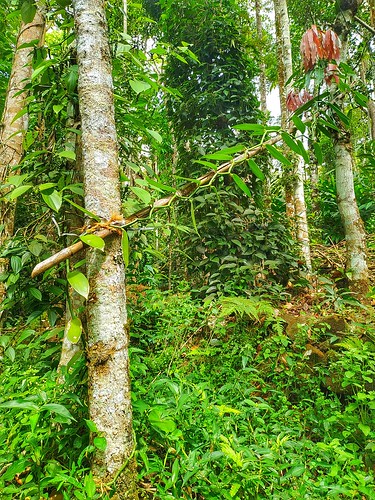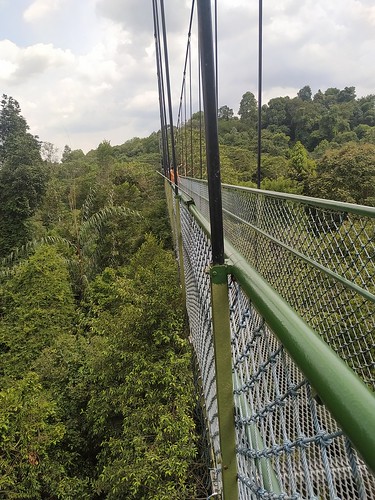
The rainforests of the Malaysian peninsula
In the first 1,5 years of the world trip, we are spending around 6 months in tropical, lush countries, and since we prefer nature to the concrete jungles, it is obvious that we planned to go to rainforests. Our first try was in India, where it is safer to get a guide. In Kerala we were suggested by several people to go to Munnar, one of the most famous tea plantation in the country, surrounded by spice plantations, this is how we ended up there after a day-long, crazy bus ride.
Even if there was a tea plantation where you can go without the guide (however 15 km by tuk-tuk is not the best for your budget), our hostel was organising a day-long tour for 7,5 euro for the following day. This tour included climbing up on some 50-degree slopes among the spice plantations, getting to know the flora and fauna (I would have never noticed those hidden gingers or coffee beans if the leader didn’t point them out), dodging stray dogs and roaming around the tea plantations. Unfortunately, it was abruptly ended by an elbow fracture – yet another reason to be happy for a guide, since without him it would have been difficult to get to the hospital in the middle of nowhere.
After these experiences, we hoped that in one of the most developed city-states in the area, Singapore we will have better chances to hike alone and we don’t need to necessarily have all the skillset of Bear Grylls. As a warm-up we started with the Botanic garden, where, for our greatest surprise, you can also find a rainforest! (Obviously, the forest was there first, they built the botanic garden around later.) We went first for the garden itself which is a wonder on its own, but later it turned out that every Saturday volunteers are leading guided tours. We were so lucky, that day was the turn of the rainforest tour! (If you happen to be there on a Saturday, check the schedule online!)
In the beginning, it was only the two of us at the registration desk, but not so much after a Thai-Singaporean couple and our tour guide showed up as well. We started with a short walk around the tropical fig trees which made our jaws drop – did you know that figs aren’t technically a fruit, they’re actually inverted flowers which are pollinated by the fig wasps crawling inside them! And those enormous trees with tangly branches – those are not branches, but roots and they are also fig trees (but also called banyan trees and they are India’s national trees, where sometimes they grow as big as a village)!
Suddenly we saw a wall of trees in front of us. We arrived in the rainforest.
Because it is a rainforest with a boardwalk in the middle, it is called a secondary forest. Our guide showed us the different leaf types and how do they try to find their ways to the sunlight and how do they try to get rid of the extensive rain. We got to know a plant that heals HIV and saw a tree planted by Nelson Mandela. We also found out that there are no annual rings in the tropics here, because winter and summer do not alternate like in Europe, so the age of the trees is determined based on the size of the tree trunk. With this information, we were able to look at the other two rainforests with a completely different perspective, which we were lucky to have over the next few days. The forest in the botanical garden can be visited in about an hour, and you can’t get lost with the boardwalk, but we recommend that you spend a full day in the garden, it is worth it! We definitely have to go back!
Singapore has many parks and hiking trails, their description can be easily found online, this is how we also found Treetop walk which was only half an hour bus ride from Little India. All the trails were marked here properly without the risk of getting lost and even if reaching the treetop walk was marked as an intermediate-difficult trail, it was rather the humidity which made it tough. On the way we’ve met monkeys and squirrels, luckily the “watch out, snake” boards didn’t live up to their menacing promises. The treetop walk leads up to a huge suspension bridge above the rainforest. There are longer walks here, you can also spend hours by the lakes, but since it started to rain (rain is rather a rule than an exception there), we jumped on the bus to see the not-so-far night safari.
After Singapore, we headed for Malaysia, where we found the world’s oldest rainforest. Taman Negara (it also means national park in Malay, so don’t get confused :)), with its 130 million years and vast size, is about 3 hours away from Kuala Lumpur and easily accessible by 2 local buses – if you don’t have to wait 4 hours for the second bus. So it is enough to leave Kuala Lumpur around 10-ish, since the second, so-called “Jungle bus” which takes you to Kuala Tahan, leaves only at 3 pm.
Unfortunately, both the departure time of the jungle bus and the opening time of the canopy walk in the forest are such kind of information what you need to handle with great flexibility. When we tried to search for them online, we found 6 different kinds of information… So, as of now, the suspension bridge is not open on Fridays, but this can change anytime.
Buses cost 19-22 (Kuala Lumpur-Jerantut) and 7 ringgit (Jerantut-Kuala Tahan), in total around 6 euro each way. The accommodation in this side of the river is cheaper (and you can cross it for 20 cents to reach the national park). In the park HQ you can buy the entrance and photo permits for 1 and 5 ringgit (20 cents and 1 euro). The permit should be given back to the staff after the tour to see that you got out alive, but we only read it afterwards, so I hope that they were not looking for us for days. You can also find multi-day hiking trails, so report your hiking plans at the office and download maps.me and the map of Malaysia for safety, as in the jungle you will not have coverage.
We were ready for the rainforest discovery on Friday and our idea was that if it doesn’t seem possible to go around without a tour guide, we’ll try to find someone the next day. Fortunately, that wasn’t the case, so after the morning warm-up walk, which also took us across the boardwalk, we headed for the deep forest. After 1 kilometre, the planks were gone and we continued on a mountain road, often climbing the roots of trees or pulling ourselves up with ropes and descending with their help. As soon as we reached the refuge, there were a few bunk beds in the wild so we could spend the night there if we really wanted to. Theoretically, besides monkeys, monitors, squirrels and leeches, there are tigers in the woods, so whatever rows your boat, we just went back to our nice homestay instead. 🙂 (Plus, the refuge looked like the kindergarten in Chernobyl, so I am not sure I would have stayed there anyway!)
It was an unbelievable experience to visit all these three forests and we were super glad that we didn’t need to have a guide after India! (This is how low-budget travelling rolls 😊)
Which is your favourite rainforest?












